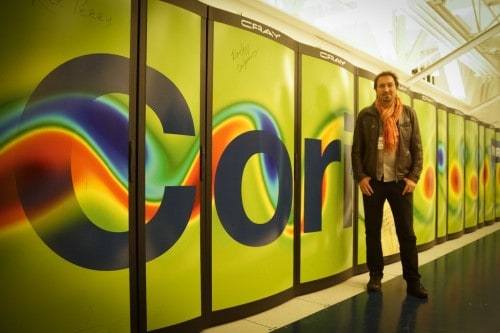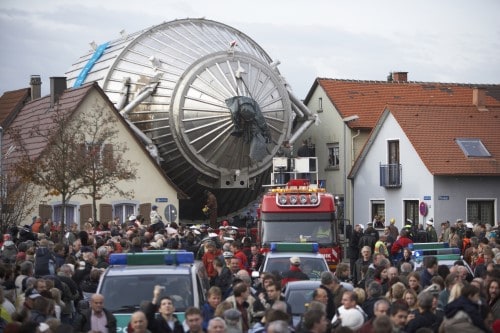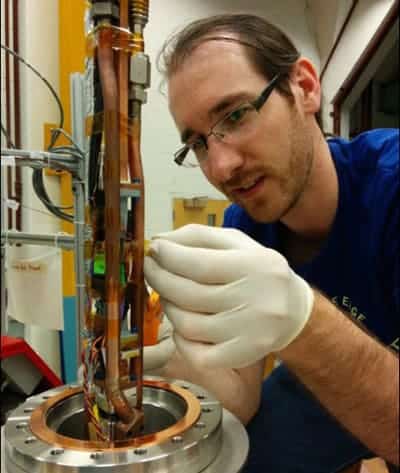Physicist Björn Lehnert from the Lawrence Berkeley National Laboratory talks to Richard Blaustein about what a new precise measurement of the neutrino means for particle physics

Based at the Lawrence Berkeley National Laboratory in the US, Björn Lehnert is a neutrino physicist who originally did a PhD at the Technische Universität Dresden in Germany on the GERDA experiment. Following a postdoc at Carleton University in Canada, he moved to California in 2018, where he works on the double-beta-decay experiment LEGEND. He is also part of the KATRIN collaboration, which today in Nature Physics reports a new upper limit on the mass of the neutrino.
Can you explain what KATRIN (the Karlsruhe Tritium Neutrino Experiment) is designed to do?
KATRIN, which is based at the Karlsruhe Institute for Technology in Germany, was inaugurated in 2018 and is a collaboration between the Czech Republic, Germany, Russia, the UK and US. It consists of about 130 scientists and is the only experiment that can make direct measurements of neutrino mass.
How do you measure the mass of a neutrino?
Neutrinos are the most abundant – and elusive – particles in the universe and measuring neutrino mass is very difficult. There are several approaches, some are model dependent in that they are based on assumptions about the universe. First there is the cosmological approach that considers where neutrinos have influenced the evolution of the universe, specifically in the creation of large-scale structures such as galaxy clusters. If neutrinos are light, it would favour the formation of smaller-scale structures, while heavier neutrinos disfavours smaller structures. By measuring the distribution of smaller and larger structures in the universe, it is possible to infer the neutrino’s mass. Another method is double-beta-decay experiments that search for whether neutrinos are their own antiparticles, so called Majorana particles.
So how does KATRIN measure mass?
KATRIN’s main component is the world’s largest spectrometer – measuring 23 metres long and 10 metres wide – to boast an ultrahigh vacuum. Tritium – an isotope of hydrogen – undergoes beta decay, producing an electron and an antineutrino. We then guide the electrons into the spectrometer without changing their energy. We cannot measure the neutrino directly because it is so weakly interacting, but we can precisely measure the electron’s energy. As both particles share energy, it is possible to resolve the small influence from the neutrino’s mass by looking at the electrons with the highest energies in the spectrum.
KATRIN has today announced an upper limit for the neutrino mass of 0.8 eV. What does this signify?
KATRIN started its five-year run in 2019 and this is the first time any lab experiment has produced the required sensitivity to rule out the mass of the neutrino being greater than 0.8 eV (Nature Physics). That is a real advance as it breaks the “psychological barrier” that we had in not knowing whether the neutrino is heavier than 1 eV. Importantly, we now know that the neutrino is at least 500,000 times lighter the electron.

In 2019 the KATRIN experiment provided a first stab at the mass of a neutrino. How is this year’s result different?
This finding is the result of more data with the experiment also running at a higher tritium source strength. The initial finding showed KATRIN worked and that we could improve the mass limit by a factor of two compared to previous experiments. This result improves that mass limit by close to a factor of three.
What was your role in the experimental analysis?
I was involved in carrying out the statistical analysis using a Bayesian approach and co-leading the group looking at how electrons scatter on their way to being detected. The probability of scattering and the amount of energy they lose when they scatter is crucial to obtaining a high precision result that allows you to then extract the neutrino mass. Cyclotron radiation from a single electron is measured for the first time
What’s next for KATRIN?
KATRIN will run for another three years and in that time we will get better statistics. We then expect the uncertainty from the measurement statistics to be roughly the same as systematic uncertainties from the experimental set-up. We will then stop the measurement expecting a final sensitivity of about 0.2 eV.
And what about beyond KATRIN?
The limiting factor of KATRIN is chemistry because we use molecules of tritium (T2). Molecules are complex objects – they have more degrees of freedom than atoms – so every decay is a little bit different, and the final state of electrons have a distribution. At some point, we cannot improve neutrino mass measurements because the initial decay has an uncertainty. The only way to improve is to use atomic tritium. This is planned for a future experiment called Project 8, which is promising but will be some years yet before it comes online.



